Bio: Wohld, Mark & Lou (Sunshine Valley Cheese Factory)
Contact:
stan@wiclarkcountyhistory.org
Surnames: Wohld, Furman, Johnson
----Source: Jack Johnson Diary - from Janet Rogalski Scrapbook
Sometime between 1925 and 1928, as nearly as I can reconstruct, John Marquis
(Mark) and Anna Louisa (Lou Furman) WohId sold their dairy farm south of
Thorp Wisconsin, arid purchased a Cheese factory about 4 miles east and 2 miles
south from the farm. It called the Sunshine Valley as Cheese Factory, and indeed
sat in a small glen along the banks of Sterling Creek, a branch of the South
Fork of the Eau Claire River. The location was on Bachelors Avenue between
Colby Factory Road and Bill's Road. But the stream will be forever known by
those of my generation as "Grampa's Crick". It was the most fun place in
the world for us kids to play. It was a very, very special place. I remember
trying to catch minnows. And throwing stories. And wading. And swimming,
well, kind of, in a crick that's only about a foot deep at the deepest.
Mark and Lou lived above the factory and made cheese until their retirement in
the early spring of 1942. Mark died in April, 1942.
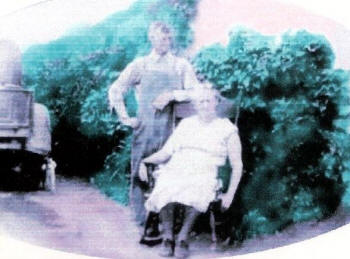
Above is a picture of Mark and Lou sitting in front of the factory and just to
the south of the southeast entrance to the building. The colorization was
done from a black and white original, so the factory color is done from memory.
The actual color was probably a little paler, and perhaps a bit
greyer. This picture was probably taken about 1940 or 1941.
In addition to the Factory, there was a small general store that was taken care
of by Gramma Wohld. It was on the far south arid of the factory, and
the store entrance is just to the right of the above photo. They also sold gas.
The pump had a big glass graduate about 6 feet off the ground, you had
to hand pump the gas into the glass until you had the right number of gallons,
and then you could use the hose and put it into your car.
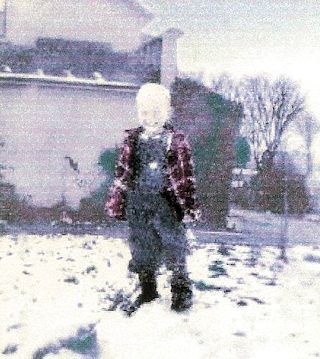
Above is a picture of a really cute little kid, probably about four or five
years old, taken from the south lawn and looking north. The date is
probably 1938 or 1939. The store occupies the small lean-to part that has the
roof sloping toward the camera. The store entrance is in the dark
attachment just behind my left arm.
My parents lived at the factory on at least two occasions, perhaps three,
however, the dates are not recorded, run- do I have a reliable recollection.
I do recall on the morning of December 8, 1941, a neighbor entered the store and
asked my grandmother "Did you hear what those Japs did at Pearl
Harbor"? Thus began my education regarding global affairs, because I knew not
where Pearl Harbor was nor who the ,raps were, but I do know that we
were living at the factory at the time. Within a month or two, the Factory was
sold due to Mark's illness (stomach cancer) and we all moved into the
village of Thorp.
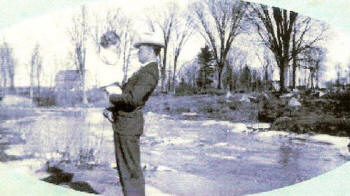
Above we see Raymond Wohld holding my sister Beverly. They are standing by
Grampa' a Crick and the time is most likely the spring of 1934, because
Beverly looks to be about two years old, and the ice is just about gone from the
stream. The cheese factory is to the left of the picture. Raymond is the
youngest of any mother s three older brothers. The crick had practical value,
too. It provided the water for the boiler and clean-up.
Slightly upstream from this picture there was a small dam for a stable water
supply.
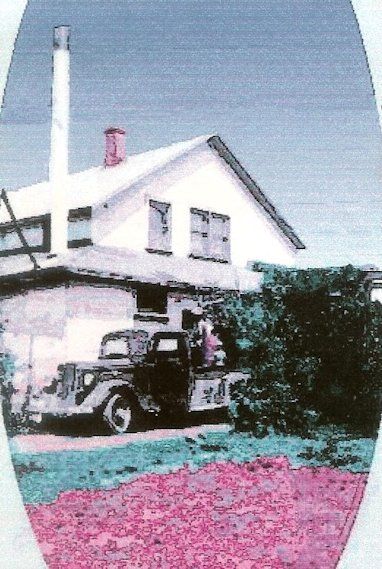
Above, the camera is at the far southwest corner of the Factory lot and looking
northeast. The pickup truck is a 1932 Ford, and my dad, Russell Johnson and
I are in the truck box, where he is loading something into the boiler room of
the factory.
The smoke stack is for the boiler, needed because cheese-making requires some
amount of heat. The walls of the cheese-making vat are hollow an that
steam can circulate and heat the milk. The process involves curdling the milk to
thicken it and to do so by enhancing the growth of a certain
bacterium in the milk. The bacterium is in the starter, or culture, that is
saved from day to day for the next batch, and it dictates the kind of cheese
that will be made. Grampa only made American cheese, which is now called
cheddar. Using a different starter culture and a different curdling
temperature would produce a different cheese and a different flavor.
Considerable skill and experience are needed to make good cheese. That was
true in the 1930's and it remains true today. At about the time of Mark and
Lou's marriage, Mark was a cheese maker in the 'vicinity of Neenah,
Wisconsin. It is not clear to me how he learned the cheesemaking art, however,
there is a record that he won a prize for his cheese at that time.
The windows on the second floor served the living quarters.
At the time of the above photo, approximately 1937, all milk was delivered to
the factory in milk cans every day to assure that the milk was always
fresh. Cans were brought up to the intake at the front of the factory, just
around the corner to the right of this picture. There are ma photos that I
am aware of that show the front of the factory, at least there are none in my
collection.

Energy sources have certainly changed over the years. The boiler in Grampa's
factory was fired with wood! Each year, they had to break away
from their cheese-making chores and go into the woods and cut wood, tons of it,
to last through the entire year, especially the winter. In the photo
above, estimated to date from the late 1930's, we see Raymond and probably one
of my mother a other brothers, Verona. I know the one on the left is
Raymond, because he is the only one I knew in those days who wore a suit and
tie, and on a regular, daily basis. I remember him as always being
impeccably dressed, a real classy guy.
The boiler room is the structure at tine right of the picture. The barn in the
background is the same one that can be seen in the picture of Raymond
and Beverly, arid our beloved crick sits between the wood piles arid the barn.
Right in front of Raymond and Verona, if you look closely, there is a
separation between the rows of carefully stacked wood. That s the driveway from
the road to the garage at the far left. Notice the open door. The photo
was taken looking almost straight north, however, it s a mystery as to how the
person taking the picture achieved such an elevated position.
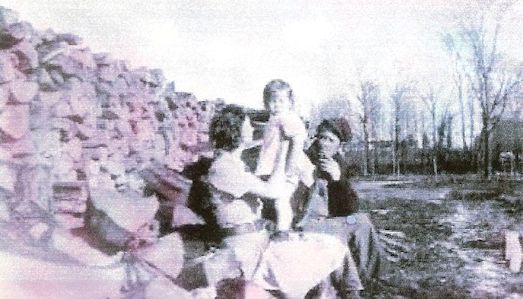
The wood pile must have also had some social purpose. Here are my parents,
Eunice and Russell, with my sister, Beverly, talking a few moments out for
what today we would call quality time . They probably took advantage of a warm
day and a need to just be alone. My estimate is that late picture dates
to the spring or fall of 1933. Bev appears to be more than a year old, but
probably not yet two.
My dad enters prominently into the picture not Just because of the obvious
biological reasons. but moreof the unique relationship he had with Mark, his
father-in-law. It was very
special, and think most observers would say, unlikely. Why is that? Because the
two men were so unlike each other, almost opposites of one another.
Grampa was a "'very soft-spoken, thoughtful and unassuming gentleman. My dad, in
contrast, was short-tempered, quick to jump to conclusions,
oftentimes emotional, and inclined to express anger abruptly. His language at
times could make a Marine drill sergeants ears turn red. But I never,
ever heard my Grampa say so much as a cross word, and certain-11y never hear him
swear or use any kind of profane words_ My dad, in my opinion, was the
major beneficiary of their relationship, and he knew it. he always spoke
respectfully and admirably of his father-in-law, and he openly wept when he
heard of Grampa s death.
Those days in the cheese factory were very special. They bring back only fond
memories. My dad was an unreconstructed addict to all dairy products,
good, bad or awful, but especially he had a taste for cheese ... aged cheddar
cheese ... really old aged cheddar cheese. I inherited that taste
from him and my Grampa. That makes me doubly fortunate, and made the factory
important. First, there was the fresh curd. Right after it was salted and
agitated, it had a fresh flavor and squeakiness that would fade in a few hours.
And I think the highlight of the taste feats was when the cheese
wholesale buyer would come around and buy Grampa s cheese. The cheese was
normally put up in 35 pound daisies, wrapped with cheese
cloth and dipped in paraffin, and then placed in round, wooden cheese boxes.
Each daisy was dated and the factory identified right on the cheese. The
cheeses were stored in the warehouse on the earth end of the factory until the
buyer came through. The buyer had to sample each batch of cheese. We had
a special cheese sampler that consisted of a blade that was railed into a small
circle about 1/4 inch in diameter. To sample the cheese, the lid would
come off the cheese boat, and the circular sample thrust into the block of
cheese and when pulled out, it carried a 3 inch long, 1/4 inch diameter tube
of solid cheese. Was it my imagination, or was that really the best tasting
cheese in the whole world? I think it was not my imagination.
Today, the factory is gone, like an many that used to dot the dairy land
countryside of Wisconsin. The dam on Sterling Creek is knocked down or
fallen over. Part of one year, the fall and early winter of 1941, Bev and I went
to the little two-room school near the factory, the Goff School. It
too, is gone. Good riddance, but that s a story for another time.
Jack L Johnson
19 June, 2006
Footnote: If anyone has any pictures of the factory, especially of the front, I
would really love to have a copy. I could easily blend it into the
narrative, above. Also, if ye have any other photos and/or comments, feel free
to add to this brief essay, and add your name to the credits, too. Send
me a copy if you do.






